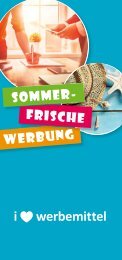2021059_TML_Manual_ENT_KidsTeens_21_online
You also want an ePaper? Increase the reach of your titles
YUMPU automatically turns print PDFs into web optimized ePapers that Google loves.
4.3. ACTIVITY AND GROUP GAMES
Seashell game (Music-stops game)
The children are swimming through the sea (inside or
outside), when the music stops the entertainers
become big seashells and the small fish (children) find
shelter in the arms of these seashells. Otherwise the
big crab (child or entertainer) will come and pinch them
in the bottom.
Warm-up game “Nemo” (Musical-stops game)
All fish (children) are swimming through the sea (room
or garden) accompanied by lively music. When the
music stops the entertainer gives them a chore, that
they need to solve commonly.
n All fish swim through the entertainer’s legs (bridge)
n All fish rub against each other with their backs
n All fish press their feet together
n All fish welcome each other with a flock of their fins
(shake hands)
Little gymnasts really big
Material: 4 cuddling toys or animal posters: dog (or cat),
bird (or butterfly), snake
(or caterpillar) and elephant (or bear)
Preparation: Distribute the animals
(garden or room)
Game: The children are moving around in the room,
every time they pass one of the animals they change
their form of movement.
Dog: Crawl on all fours
Bird: Spread the arms and fly like a bird
Snake: Lay on the floor and wriggle like a snake
Elephant: Stomp on the floor
Alternative for older children:
The entertainer shows alternating animals, the kids
move accordingly.
Cookie eating
In the beginning organise two groups of children. There
are cookies on a table which is located in some meters
distance. Now one participant of each group runs to the
table, eats one cookie and screams out “Olé” then he
runs back to his group. The group who finishes first is
the winner.
Ice floes
There is a marked up distance. Then the children are
organised into two groups.
The first two children take four ice floes (made of cardboard)
each and which have been prepared before. The
relay race starts upon a starting signal. Both children
place the first ice floe before them, jump on it and position
the second floe. This is to be repeated until they
have reached the finish line. Going back they need to
collect the ice floes again and give them to the next
child. Again the group who finishes first is the winner.
Sack racing
Two groups compete against each other. The first
player of each group starts sack racing after the start
signal has been given. The distance to hop along is up
to the finish line and back to the start again. Then it is
up to the next player and so on. The group who is fastest
wins.
Musical chairs
Set up chairs in two rows or a circle (one chair less than
children participating). When the music starts the children
start running around the chairs, as soon as the
music stops each child needs to sit on a chair. The child,
who does not find a chair, leaves the game. A new
round starts with again one chair less than children.
The child who in the end sits on the last chair is the
winner.
Hat dance
The children dance in a circle to the music and a hat is
passed from head to head of the children. When the
music stops the child wearing the hat leaves the circle.
In the final round there are only two children left. The
put on the hat, turn and pass the hat to the other child.
Winner is who isn’t wearing the hat when the music
stops.
Egg and spoon race
Organise two groups of the same size. The first child of
each group obtains a spoon and a hardboiled egg,
which is to be placed on the spoon. With the starting
signal the children start running to the finish line and
back. In no case they shall loose or drop the egg. Then
it is up to the next child. The group finishing first is the
winner. (You can also use Ping-Pong balls instead of
eggs.)
Obstacle race
Set up two same obstacle courses next to each other
(slalom with arm chairs, somersault on a mat, throwing
and catching a ball, jumping on one leg, etc …), then
organise the children in two groups of the same size
and start the race. Winner is the group whose participants
were fastest.
Kids & Teens Club Manual 53



